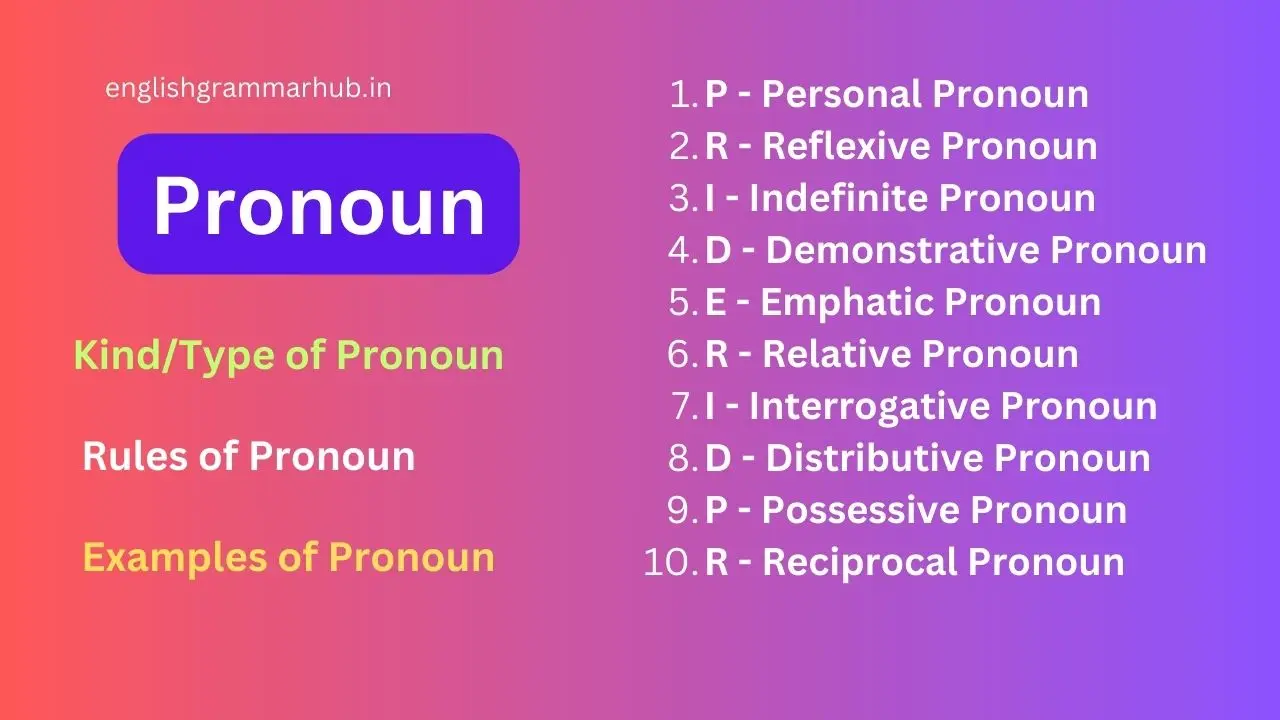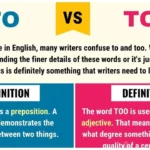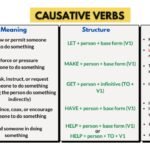Pronoun in Hindi: दोस्तों, आप सभी का स्वागत है हमारे इस पोस्ट में, इस पोस्ट में हमने Pronoun की परिभाषा, उदहारण के साथ-साथ उसके रूल के बारे में भी विस्तार से बताया है| यदि आप कोई प्रतियोगिता परीक्षा की तैयारी कर रहे है तो यह पोस्ट आपको बहुत ही ज्यादा मदद करने वाली है| हमें उम्मीद है कि इस पोस्ट को अंत तक पढ़ने के बाद आपका Pronoun से जुड़े सादे डाउट ख़तम हो जायेंगे|
Pronoun in Hindi
Pronoun in Hindi ( सर्वनाम की परिभाषा): सर्वनाम वह शब्द है जिसका प्रयोग संज्ञा के स्थान पर किया जाता है|
Definition of Pronoun: A pronoun is a word used at the place of noun.
Example: He, She, It, They etc.
- मैं – I – मैं बहुत खुश हूँ| – I am very happy.
- तुम – You (informal) – तुम कहाँ हो? – Where are you?
- वह – He/She/It – वह एक अच्छा व्यक्ति है। – He/She/It is a good person.
- खुद – Oneself/Itself – वह अपने खुद को सजाने में व्यस्त था। – He was busy decorating himself.
- कोई – Someone/Anyone – क्या कोई यहाँ है? – Is someone here?
- कुछ – Something – मुझे कुछ खाने का मन है। – I feel like eating something.
- कोई भी – Anyone/Anything – आप कोई भी काम कर सकते हैं| – You can do anything.
- हम – We – हम एक साथ खेल रहे थे| – We were playing together.
- आप – You (formal/plural) – आप कैसे हैं| – How are you?
- वे – They – वे अच्छे दोस्त हैं| – They are good friends.
Meaning of Pronoun in Hindi
Pronoun को हिंदी में ‘सर्वनाम’ कहते हैं| सर्वनाम का प्रयोग नाउन के बदले में किया जाता है|
Meaning of Pronoun – सर्वनाम
Pronunciation of Pronoun – प्रोनाउन
Kind/Type of Pronoun in Hindi
आप सभी को बता दे कि Pronoun मुख्यत: 10 प्रकार के होते है| जिसके बारे में हमने नीचे विस्तार से बताया है|
PRIDE RID PR (प्राईड रीड पी आर)
- P – Personal Pronoun
- R – Reflexive Pronoun
- I – Indefinite Pronoun
- D – Demonstrative Pronoun
- E – Emphatic Pronoun
- R – Relative Pronoun
- I – Interrogative Pronoun
- D – Distributive Pronoun
- P – Possessive Pronoun
- R – Reciprocal Pronoun
1. Personal Pronoun
Personal Pronoun तीन व्यक्तियों का बोध कराता है| 1st Person, 2nd Person तथा 3rd Parson नीचे दिए गए टेबल की मदद से आप आसानी से समझ सकते है| साथ ही आप इसे समझने के लिए फैक्ट्स को भी पढ़ सकते हैं|
Personal pronoun is a stand of three person:
| Persons | Subjective Case | Passive Case | Objective Case |
| 1st | I, We | My/mine, Our/ours | Me, Us |
| 2nd | You | Your/Yours | You |
| 3rd | He, She, It, They, One | His, Her/Hers, There/There’s, Ones | Him, Her, It, Them, One |
Fact (1) If different kinds of person come together in a same sentence are a arranged to two three one (231) order. – यदि विभिन्न प्रकार के व्यक्ति एक ही वाक्य में एक साथ आते हैं तो इसे दो तीन एक (231) क्रम में व्यवस्थित किया जाता है।
Example: I, Ram and you performed well in exam. – मैंने, राम और आपने परीक्षा में अच्छा प्रदर्शन किया।
Note (i) 23 – यदि
Example: Ram and you performed well in exam. (x) / You and Ram performed well in exam. (✓)
उदाहरण: राम और आपने परीक्षा में अच्छा प्रदर्शन किया। (x) / आपने और राम ने परीक्षा में अच्छा प्रदर्शन किया। (✓)
Note (ii) 31
Example: I and Ram performed well in exam. (x) / Ram and i performed well in exam. (✓)
उदाहरण: मैंने और राम ने परीक्षा में अच्छा प्रदर्शन किया। (x) / राम और मैंने परीक्षा में अच्छा प्रदर्शन किया। (✓)
Note (iii) 21
Example: I and you performed well in exam. (x) / You and i performed well in exam. (✓)
उदाहरण: मैंने और आपने परीक्षा में अच्छा प्रदर्शन किया। (x) / आपने और मैंने परीक्षा में अच्छा प्रदर्शन किया। (✓)
Fact (2) If different type of person come together and the accept to guilt or are plural , are arranged into ‘One Two Three’ (123) order. – यदि विभिन्न प्रकार के व्यक्ति एक साथ आते हैं और अपराध स्वीकार करते हैं या बहुवचन होते हैं, तो उन्हें ‘एक दो तीन’ (123) क्रम में व्यवस्थित किया जाता है।
Example: Ram, i and you where going to kill Mohan. (x) / I, you and Ram where going to kill Mohan. (✓)
उदाहरण: राम, मैं और तुम मोहन को मारने वाले हैं। (x) / मैं, तुम और राम कहां मोहन को मारने जा रहे हैं। (✓)
Fact (3) If different kinds of persons come together and first person is also representing then get there joined person from (we, our, ours) group. – यदि विभिन्न प्रकार के व्यक्ति एक साथ आते हैं और पहला व्यक्ति भी प्रतिनिधित्व कर रहा है तो वहां (हम, हमारे, हमारे) समूह से व्यक्ति को शामिल करें|
Example: You, Ram and i high performed your duty honestly. (x) / You, Ram and i high performed our duty honestly. (✓)
उदाहरण: आपने, राम और मैंने अपना कर्तव्य ईमानदारी से निभाया। (x) / आपने, राम और मैंने अपना कर्तव्य ईमानदारी से निभाया। (✓)
Fact (4) If different type of persons come together and 1st person in not presenting name get there joined personal form you group(you, your, you). – यदि विभिन्न प्रकार के व्यक्ति एक साथ आते हैं और पहला व्यक्ति नाम प्रस्तुत न करने पर आपके समूह (आप, आप, आप) में व्यक्तिगत रूप से शामिल हो जाता है|
Example: You and Ram have performed his duty honestly. (x) / You and Ram have performed your duty honestly. (✓)
उदाहरण: आपने और राम ने अपना कर्तव्य ईमानदारी से निभाया है। (x) / आपने और राम ने अपना कर्तव्य ईमानदारी से निभाया है। (✓)
You and Ram most denoted whatever be can. (x) / You and Ram most denoted whatever you can. (✓)
आपने और राम ने जो कुछ भी हो सकता था उसका सबसे अधिक निरूपण किया। (x) / आपने और राम ने जो कुछ भी आप कर सकते हैं उसका सबसे अधिक निरूपण किया। (✓)
Some Uses of ‘It’
(i) ‘It’ comes to show a singular non-living thing.
Example: I have a pen, it is very society.
(ii) ‘It’ comes to show an animal.
Example: I have a dog, it is red.
(iii) ‘It’ comes to introduce a natural rule or event.
Example: It is raining now. / It is Monday today.
(iv) ‘It’ comes to show a little baby.
Example: I have a nephew, it is very knotty.
(v) ‘It’ comes to make a pre-statement about something.
Example: It is right that honesty is the host policy.
2. Reflexive Pronoun
A word used at the place of noun that reflects the work of subject of the subject is called Reflexive Pronoun.
Example: Myself, yourself, himself, themselves etc
Facts(i): Each a every pronoun get its particular reflexive form.
| I – Myself | She – Herself |
| We – Ourselves | It – Itself |
| You – Yourself / Yourselves | They – Themselves |
| He – Himself | One – oneself |
Facts(ii): It comes at the place of object in sentence. (After the verb / After the preposition etc.)
Facts(iii): It show hindi meaning खुद को / स्वयं को / अपने आप को
Example: He cheats my every time. / He cheats himself every time.
Note: ध्यान रहे कि इसका प्रयोग किसी वाक्य के Subject के रूप में नही होता|
Example: Ram, Shayam and myself decided to buy a new car. (x) / Ram, Shayam and i decided to buy a new car. (✓)
3. Indefinite Pronoun
A word is used at the place at noun that show the noun in indefinite way is called infinite pronoun.
Example: All, some, most, many, much, etc.
Facts(i): It is comes for countable noun gets plural verb.
Example: I have ten friends, all is very lazy. (x) / I have ten friends, all are very lazy. (✓) / All of my friends are going to Delhi. (✓)
Facts (ii): If it comes for un-countable noun gets singular verb.
Example: I have some rice, all are boil. (x) / I have some rice, all is boil. (✓) / All of the rice is boil in the kitchen. (✓)
Facts(iii): कोई Pronoun जिसका अंत one / body / thing से होता हो, उसे भी indefinite pronoun के दायरे में रखा जाता हो और इसका verb singular दिया जाता| (Someone, someday, something, anyone, anybody, anything, no one, nobody, nothing)
Note(i): Someone, somebody, something = Positive sense
Example: He is going to help any body in travel. (x) / He is going to help somebody in travel. (✓)
Note(ii): Anyone, anything, anybody = Negative Sense
Example: He is not going to help somebody in travel. (x) / He is not going to going to help anybody in travel. (✓)
4. Demonstrative Pronoun
A word used at the place of noun that’s demonstrate the noun is called demonstrative pronoun.
Example: This, that, these, those etc.
Uses ‘This’
(i) This comes to demonstrate a singular noun that is nearest to the speaker.
Example: Look here, this is my new car.
(ii) This come to introduce to someone / somebody.
Example: Meet him this is my old friend Raju. (✓)
(iii) This comes to show a visible in the sense of closeness.
Example: Look through the windows, this is the Tajmahal.
(iv) This come to make a post statement about something.
Example: Honesty is a best policy this is right.
Uses ‘That’
(i) That come to demonstrate the singular noun that is heard from speaker.
(ii) That comes to make one’s recognition.
Example: Look the on the statue, that is Varun Dhawan is red shirt.
(iii) If we talk about one person or thing use this for this second one and that for the first one.
Example: Sonia and Advani both are great leaders this belong to the BJP and that belongs on the Congress.
Use ‘These’
These comes to demonstrate plural noun that are near to the speakers.
Example: Look here, these are my new cars.
Use ‘Those’
Those comes to demonstrate plural noun that are half in the speaker.
Example: Look there in the corner, those are my old cars.
Note: Those + Who comes to replace the use of they + who in sentence.
Example: They who are siting here are very lazy. (x) / Those who are siting here are very lazy. (✓)
5. Emphatic Pronoun
A word used at the place of noun that is emphasis the noun for Emphatic Pronoun.
Example: Myself, Herself, Yourself, Itself etc.
Fact (i): Each and every personal pronoun gets its particular emphatic form.
Example: I – Myself / He – Himself etc.
Fact (ii): To emphasis subject it come to after the subject and to emphasis object, it comes just after the object.
Example: I himself can do this work. (x) / I myself can do this work. (✓)
6. Interrogative Pronoun
A word used the place of noun that arise question for the noun is called Interrogative Pronoun.
Example: Who, which, what, who etc.
Fact (i): It comes in the beginning in the sentence.
Fact (ii): It gates question make to finish its sentence.
Fact (iii): It show Hindi meaning beginning with ‘क’.
Uses of Interrogative Pronoun
1. Who comes to arise question or human being that is the subject of a sentence.
Example: Ram is a dancer. – Who is a dancer? – Ram = Subject
2. Who comes to arise question for the position of human being.
Example: Ram’s brother is a dancer. – Whose brother is dancer? – Ram’s brother
3. Whom comes to arise question for a human being that is the object of a sentence.
Example: Ram killed Ravan! – Whom did Ram killed? – Ravan
4. What comes to arise question for a Neuter Gender (Non-living) that is the subject or subject of a sentence.
Example: Plastic is burning in the room. – What is the burning in the room? – Plastic
5. Of which comes to arise question for the position of a Neuter Gender.
Example: The nib of red pen is broken. – Of which nib is broken? – The nib of the red pen.
6. Which comes to arise question or human being and Neuter gender both to make a question + solution.
Example: Who of the students can solve this question? (x) / Which of the student can solve this question? (✓)
6. Relative Pronoun
A word used at the place of noun that shows the relation of the noun is called Relative Pronoun.
Example: Who, Which, What, That etc.
Fact (i) Who comes as relative pronoun per as a human being that is the subject of a sentence.
Example: Ram which a dancer is my friend. (x) / Ram who is a dancer is my friend. (✓)
Fact (ii) Whose comes as relative for the processing of human being.
Example: Ram which brother is the dancer is my friend. (x) / Ram whose brother is the dancer is my friend. (✓)
Fact (iii) Whom comes as relative pronoun for a human being that is the object of a sentence.
Example: I know the boys about whom you are talking.
Note: ध्यान रहे कि उपरोक्त स्थिति में Whom के स्थान पर Who का प्रयोग भी तब संभव है, जब सम्बंधित Preposition वाक्य के अंतिम चरण में चला जाएँ|
Example: I know the boy who you are talking abut.
Uses of Relative Pronoun
1. Which comes as relative pronoun for a Neuter gender that is the subject of as a sentence.
Example: The pen who is red is running well. (x) / The pen which is red is running well. (✓)
2. Of which comes as the relative for the position of neuter gender.
Example: The pen of which nib is broken is not running. (✓)
Note: ध्यान रहे कि उपरोक्त स्थिति में Neuter के Position के लिए Of which के साथ पर Whose का प्रयोग भी प्रचलन में है|
Example: The pen whose nob is broken is not running.
3. That comes as relative pronoun for a neuter gender that is the subject or object of a sentence.
Example: The pen which/that nib broken is not running.
4. That comes as relative for the position of a neuter gender.
Example: The pen that bib is broken is not running.
5. If human being and neuter gender both come together gender both come together use pronoun that after themselves.
Example: I show Mohan and his car who were standing inside the road. (x) / I show Mohan and his car that were standing inside the road. (✓)
6. None / Only prefers relative pronoun that after itself.
Example: Ram is the only student who can this solve questions. (x) / Ram is the only student that can this solve questions. (✓)
7. An Indefinite pronoun prefers relative pronoun that after itself.
Example: All that glitters is not gold.
8. An Interrogative sentence prefers relative pronoun that after itself.
Example: If there anybody that can solve this question?
9. One/any + Of + Noun/Pronoun + That/who……
Example: Dhoni is one of players that/who are playing in this match. (✓) / This is one of the pens that are running well. (✓)
10. Same…. as come to make similarity between two person in the sentence.
Example: I have the same car as Ram has.
11. Same….. that comes to re introduce to now in sentence.
Example: He give me the same car which was the not running. (x) / He give me the same car that was the not running. (✓)
12. Such ….. as come to making similarity between the two person in the sentence.
Example: She is singing such sweetly which attract everybody. (x) / She is singing such sweetly that attract everybody.
13. As….as comes to make similarity between the quality of two persons of this.
Example: Ram is as smart as Shayam.
14. So….as comes to make similarity between the quantity of two persons of things.
Note: ध्यान रहे कि इसका प्रयोग केवल Negative Structure में होता है|
Example: Ram is not so smart as Shayam.
15. So + that comes to show the target of one season.
Example: I am going to Delhi, so which i can get of good job. (x) / I am going to Delhi, so that i can get a good job. (✓)
16. What comes as relative pronoun for a statement of things.
Example: What you say is not right? / What know what you say?
Fact (i): It comes amid the sentence.
Note: ध्यान रहे कि What का प्रयोग Relative Pronoun के रूप में वाक्य के शुरुवात तथा बीच में कही भी हो सकता हैं|
Fact (ii): ध्यान रहे कि Whatever का प्रयोग नहीं Relative Pronoun के रूप में हो, तो यह भी वाक्य के शुरुवात तथा बीच में कही भी रह सकते है|
7. Distributive Pronoun
A word as the Place of noun that shows the noun in Distributive Pronoun.
Example: Each, Everyone, Either, Neither etc.
Fact (i) It is singular and gets singular verb.
Example: Everyone is go there.
Fact (ii): Two distributive pronoun connected with and also make a singular formation and used singular verb.
Example: Each and everyone is ready to go there.
Fact (iii): Distributive pronoun + of + Plural (Noun/Pronoun) + Singular Verb
Example: Each of the candidates have qualified exam. (x) / Each of the candidates has qualified exam. (✓)
Fact (iv): Plural (Noun/Pronoun) + Distributive Pronoun + Plural Verb
Example: We each is ready to go their. (x) / We each are ready to goes there. (✓) or Each of us is ready to go there. (✓)
Some Uses of Distributive Pronoun
[1.] Either / Any / Anyone
Either: It comes to show two options distributive way.
Example: Any of Ram and Shayam can solve this question. (x) / Either of Ram and Shayam can solve this question. (✓)
Any / Anyone: It comes to show more then two options in distributive way.
Example: Either of the ten students can solve this question. (x) / Any / Anyone of the ten students can solve this question. (✓)
[2.] Neither / None
Neither: It’s come to neglected both of the given two options together.
Example: None of Ram and Shayam could solve this question. (x) / Neither of Ram and Shayam could solve this question. (✓)
None: It’s come to neglected on of the given more then two option together.
Example: Neither of the ten candidates could solve this question. (x) / None of the ten candidates could solve this question. (✓)
[3.] Both / All
Both: It’s comes to show two option together.
Example: All of Ram and Shayam have decided to go there. (x) / Both of Ram and Shayam have decided to go there. (✓)
All: It’s come to show both more two options together.
Example: Both of the ten candidates are ready to go there. (x) / All of the ten candidates are ready to go there. (✓)
[4.] Each / Everyone
Each: It’s comes to show two or more then two options in distributive way.
Example: Everyone of Ram and Shayam is ready to go there. (x) / Each of Ram and Shayam is ready to go there. (✓)
Everyone: It comes to show more the two options in distributive way.
Example: Everyone of the candidates is ready to go there.
Note: ध्यान रहे कि केवल दो वस्तु या व्यक्ति का चर्चा हो तो Each/Everyone का प्रयोग एक साथ नहीं हो सकता है|
Example: I have two cars but each and everyone is out of order. (x) / I have two cars but each is out of order. (✓)
9. Possessive Pronoun
A word used at the place of noun that makes position over the noun is called Possessive pronoun.
Example: Mine, Ours, Yours etc.
Fact (i): It comes as subject or object of a sentence.
Fact (ii) ध्यान रहे कि इसका प्रयोग किसी Noun के ठीक पहले नहीं आता|
Example: This is my car. (✓) / This car is my. (x) / This car is mine. (✓) / Mine is red and yours is black. (✓)
Fact (iii) A/an + Noun + of + Possessive Pronoun + Plural
Example: A car of mine. (मेरी कारो में से एक) / A friend of yours. (आपके दोस्तों में से एक)
[10.] Reciprocal Pronoun
A word used at the place of noun that makes reciprocal relation of a noun is called reciprocal pronoun.
Example: Each other, One another
Each other: It comes to make a reciprocal relation between two persons or thing.
Example: Mohan and Shayam help one other in travel. (x) / Mohan and Shohan help each other. (✓)
One another: It comes to make a reciprocal relation among more then two persons or things.
Example: All the five friends help each other in travel. (x) / All the five friends help one another in a travel. (✓)
Uses of Some Reciprocal Pronoun
[1.] Two subject connected with as will as, along with, rather then, except, like in addition to, together with, with and not etc gets pronoun and verb according to the first part.
Example: (i) I as will as you are doing your duty honesty. (x) / I as will as you an doing my duty honesty. (✓)
[2.] To subject connected with or / nor / not only …..but also etc. get pronoun or verb according to the second part.
Example: Neither Mohan not Sita has formed his duty honesty. (x) / Neither Mohan not Sita has performed her duty honesty. (✓)
Note: ध्यान रहे कि यदि उपरोक्त से एक Singular तथा एक Plural पक्ष जुड़ा रहे तो Singular पक्ष पहले तथा Plural बाद में रखा जाता है|
[3.] If more post then one comes together one only gets article make a singular formation and used personal form.
Example: The principle and president of the college has performed their duty honesty. (x) / The principle and president of the college has performed there duty honesty. (✓)
[4.] If more past then one come together and all gets article make or plural formation and used personal form – They Group.
Example: The principle and the president of the college his performed their duty honesty. (x) / The principle and the president of the college had performed their duty honesty. (✓)
[5.] If the members of distributive collective noun are unanimous make a singular formation and used pronunciation form – It Group
Example: The committee has taken their decision in the case. (x) / The committee has its decision in this case. (✓)
[6.] If the member of the Distributive Collective Noun in opinion make a plural formation and used plural form – They Group
Example: The committee had not taken its decision in this case. (x) / The committee had not taken their decision in this case. (✓)
[7.] A pronoun ending with one / body gets personal form – He / She Group
Example: Somebody has left there in pen in the class. (x) / Somebody has left he/her in pen in the class. (✓)
[8.] A pronoun ending with ‘Thing’ gets personal form – It Group
Example: Something is boring of there place. (x) / Something is boring of it place. (✓)
[9.] Both / Many / Several / Few / A number of etc = They Group
Example: Both of the student have performed his duty honestly. (x) / Both of the student have performed their duty honestly. (✓)
[10.] Much / Little / A mouth of etc = It Group
Example: Much of the rice is reaming of there place. (x) / Much of the rice is reaming of it place. (✓)
[11.] All / Some / Most / A lot of / A lots of / A great deal / A good deal etc for countable noun = They Group
Example: All of the students have performed their duty honestly. (✓)
[12.] All / Some / Most / A lot of / A lots of / A great deal / A good deal etc for uncountable noun = It Group
Example: All of the rice is reaming if its place. (✓)
[13.] A distributive pronoun (each, everyone, either and neither) gets personal form – He / She / It Group
Example: Each has performed their duty honestly. (x) / Each has performed his/her duty honestly. (✓)
[14.] Distributive pronoun + of + you = You Group
Example: Each of you had performed your duty honestly. (✓) / Each of you must do not whatever you can. (✓)
[15.] Distributive Pronoun + of us = We Group
Example: Each of us had performed our duty honestly. (✓)
[16.] Distributive pronoun + of them = He / She / It Group
Example: Each of them had performed their duty honestly. (x) / Each of them had performed he/her duty honestly. (✓)
[17.] Distributive Pronoun + of + plural noun = He / She / It Group
Example: Each of the boys had performed his duty honestly. (✓) / Each of the girls had performed her duty honestly. (✓) / Each of the pens is remaining of its place. (✓)
Conclusion:
इस पोस्ट में हमने Pronoun के बारे में विस्तार से समझने की कोशिश की है, उम्मीद है कि आप सभी को यह समझ आया होगा| यदि आपके मन कोई भी सवाल हो तो हमें कमेंट में पूछ सकते है| इसके अलावा आपसे बिनती है कि यदि आपको इस पोस्ट से कुछ नया सिखने को मिला है तो अपने दोस्तों के साथ जरुर शेयर करें|
Read Also:






